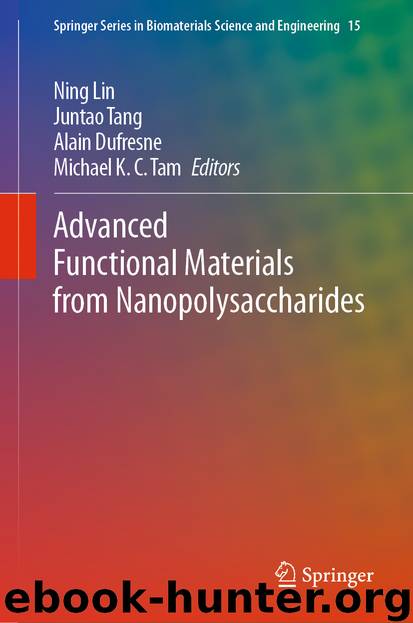Advanced Functional Materials from Nanopolysaccharides by Ning Lin & Juntao Tang & Alain Dufresne & Michael K. C. Tam

Author:Ning Lin & Juntao Tang & Alain Dufresne & Michael K. C. Tam
Language: eng
Format: epub
ISBN: 9789811509131
Publisher: Springer Singapore
5.4.2.3 Starch-Based Bone TE Scaffolds
A blend of starch with polycaprolactone (SPCL) and poly(lactic acid) (SPLC) was used to prepare bone TE scaffolds that possessed adequate porosity and mechanical properties for enzymatic degradation and cell proliferation [192]. Another study confirmed that sustained cell proliferation, osteogenic differentiation, and mineralization formation on human adipose stem cells (hASC) in 3D fiber meshes SPCL scaffolds treated with calcium silicate for in situ functionalization of Si–OH groups [193]. Also, electrospun hierarchical SPCL scaffolds comprising of parallel aligned microfibers and randomly blended nanofibers of polycaprolactone showed good cell proliferation and osteoblastic activity [194]. The immunogenicity of starch-based scaffolds incorporated with ethylene vinyl alcohol (SEVA-C), cellulose acetate (SCA), and SPCL composite with the presence of hydroxyapatite (HAT) was evaluated, and SEVA-C scaffolds presented a higher number of cells compared to SCA and SPCL composite, while SCA scaffolds induced a low level of toxicity that resulted in delayed cell proliferation [195]. SPCL and SCA scaffolds stimulated in vitro tissue response and angiogenic activation of outgrowth endothelial cells without supplementation of growth factors, as well as in vivo results showed greater vascularization after subcutaneous implantation [196]. Another in vivo results of endosseous response to SCA, SEVA-C, and SEVA-C with phosphate layer (SEVA-C/CaP) scaffolds showed a favorable response for bone generation. However, SEVA-C scaffolds did not show any bone contact and SEVA-C/CaP exhibited only transitory bone contact after 3 weeks while SCA showed direct bone contact after 6 weeks of implantation [197].
Most recently, starch-derived nanographene oxide (nGO) was incorporated with starch-based nanofiber scaffolds in formic acid by electrospinning method, and the addition of nGO enhanced electrospinning ability, thermal stability, biodegradability, biocompatibility, and osteo-bioactivity of starch scaffolds [198]. A citric acid modification of starch-based hydrogel scaffolds have been used to mimic bone-like apatite layers, and primary heterogenous nucleation of apatitic calcium phosphate was observed due to greater chemical affinity of carboxyl group in citrate-starch hydrogel scaffolds [199].
Download
This site does not store any files on its server. We only index and link to content provided by other sites. Please contact the content providers to delete copyright contents if any and email us, we'll remove relevant links or contents immediately.
| Automotive | Engineering |
| Transportation |
Whiskies Galore by Ian Buxton(40330)
Introduction to Aircraft Design (Cambridge Aerospace Series) by John P. Fielding(32338)
Small Unmanned Fixed-wing Aircraft Design by Andrew J. Keane Andras Sobester James P. Scanlan & András Sóbester & James P. Scanlan(32141)
Craft Beer for the Homebrewer by Michael Agnew(17445)
Turbulence by E. J. Noyes(7038)
The Complete Stick Figure Physics Tutorials by Allen Sarah(6638)
Kaplan MCAT General Chemistry Review by Kaplan(6053)
The Thirst by Nesbo Jo(5785)
Bad Blood by John Carreyrou(5768)
Learning SQL by Alan Beaulieu(5411)
Weapons of Math Destruction by Cathy O'Neil(5036)
Man-made Catastrophes and Risk Information Concealment by Dmitry Chernov & Didier Sornette(4735)
iGen by Jean M. Twenge(4702)
Digital Minimalism by Cal Newport;(4540)
Life 3.0: Being Human in the Age of Artificial Intelligence by Tegmark Max(4507)
Audition by Ryu Murakami(4098)
1,001 ASVAB Practice Questions For Dummies by Powers Rod(4038)
Electronic Devices & Circuits by Jacob Millman & Christos C. Halkias(4027)
Pale Blue Dot by Carl Sagan(4001)
